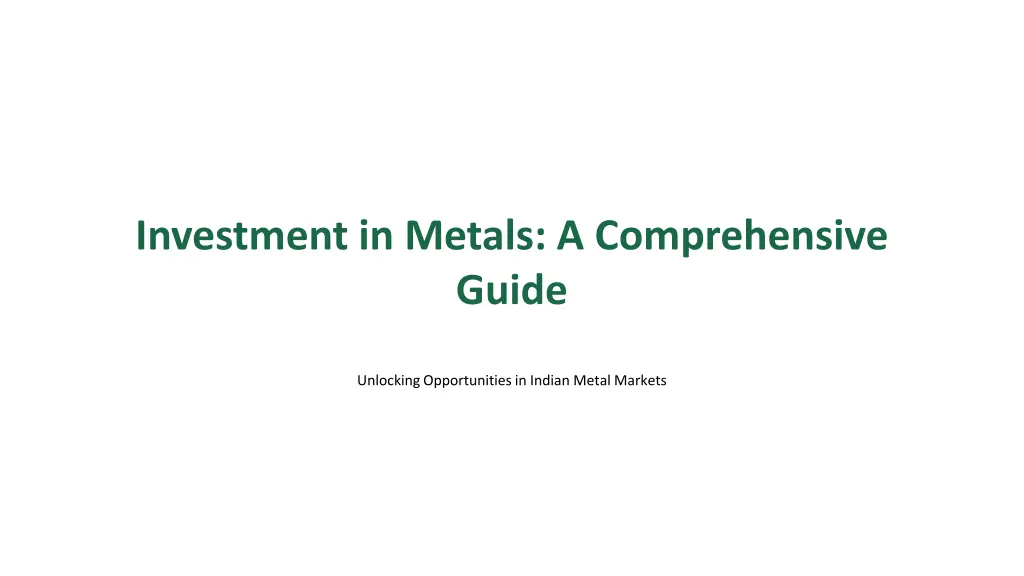
Unlocking Opportunities in Indian Metal Markets - Comprehensive Guide
Explore the history, types, trading platforms, advantages, risks, and regulations of metal investment in India. Discover how metals can enhance your investment portfolio and the various trading options available in the Indian market.
Download Presentation

Please find below an Image/Link to download the presentation.
The content on the website is provided AS IS for your information and personal use only. It may not be sold, licensed, or shared on other websites without obtaining consent from the author. If you encounter any issues during the download, it is possible that the publisher has removed the file from their server.
You are allowed to download the files provided on this website for personal or commercial use, subject to the condition that they are used lawfully. All files are the property of their respective owners.
The content on the website is provided AS IS for your information and personal use only. It may not be sold, licensed, or shared on other websites without obtaining consent from the author.
E N D
Presentation Transcript
Investment in Metals: A Comprehensive Guide Unlocking Opportunities in Indian Metal Markets
01 My Introduction Table of Contents 02 History of Investment in Metals in India 03 Types of Metals for Investment 04 Where are Metals Traded in India? 05 Advantages in Investing in Metals 06 Risks in Investing in Metals 07 Taxability and Regulations for Metal Trading in India 08 Conclusion
1 My Introduction Hello everyone! I'm delighted to share insights into the fascinating world of metals investment. As an industry expert, my journey has revolved around understanding economic trends and investment strategies. Today, we ll explore how metals can be a vital part of your investment portfolio. Together, we'll uncover the history, types, trading platforms, advantages, risks, and regulations of metal investing in India. Let s embark on this enlighteningjourney together!
2 History of Investment in Metals in India The history of metals investment in India dates back centuries, with gold and silver playing pivotal roles in trade and culture. During ancient times, these metals were not just currency; they were symbols of wealth and status. Post-independence, the Indian government took significant steps to regulate and promote metal investments. With growing economic liberalization, investment patterns in metals have evolved, leading to increased participation. Today, metals remain a cornerstone of investment strategies for individuals and institutions alike.
3 Types of Metals for Investment Investors can choose from various metals based on their goals and market conditions. 1. Gold: A safe-haven asset known for its stabilityand value retention. 2. Silver: A versatile metal with both industrial and investment value. 3. Platinum: Rare and valuable, often used in jewelry and automotive industries. 4. Palladium: Growing in demand for its application in electronics and automotive sectors.
4 Where are Metals Traded in India? In India, metals are traded on various exchanges that facilitate price discovery and liquidity. Key exchanges include the Multi Commodity Exchange (MCX) and the National Commodity & Derivatives Exchange (NCDEX). These platforms provide investors with access to real-time market data and tradingopportunities. Investors can also explore over-the-counter(OTC) tradingand direct purchases from jewelers. Emerging digital platforms are making metal tradingmore accessible for retail investors.
5 Advantages in Investing in Metals Metals offer several compelling advantages for investors looking to diversify their portfolios. 1. Hedge Against Inflation: Metals often retain value when traditionalcurrencies fluctuate. 2. Portfolio Diversification: Including metals can reduce overall portfolio risk. 3. Liquidity: Popular metals like gold and silver are easily tradable and convertible to cash. 4. Tangible Assets: Unlike stocks, metals can be held physically, providinga sense of security.
6 Risks in Investing in Metals While investing in metals can be lucrative, it comes with inherentrisks that investors must consider. Market Volatility: Prices can fluctuate significantlybased on global economic factors. Storage & Insurance: Physical metals require secure storage and insurance costs, impacting overall returns. Regulatory Changes: Government policies on mining, import, and taxation may affect metal prices. It's essential to conduct thoroughresearch and weigh these risks against potentialrewards.
7 Taxability and Regulations for Metal Trading in India Understanding the tax implications and regulationsgoverning metal trading is crucial for investors. Capital Gains Tax: Profits from selling metals are subject to capital gains taxation, with varying rates based on the holding period. GST: Goods and Services Tax applies to metal transactions, affecting total investment costs. Regulatory Bodies: The Forward Markets Commission regulates commodity futures to ensure fair trading practices. Staying updatedwith legal changes is vital for compliant and informed investing.
8 Conclusion In conclusion, investing in metals can offer substantial benefits and opportunities for growth. With a rich history and a variety of trading platforms, investors can navigate this dynamic market. Understanding both the advantages and risks is essential for making informed decisions. As we move forward, embracing diversification and knowledge will pave the way for successful investing. Thank you for joining me today; let s invest wisely and unlock the potential of metals!
